
Pictured from left to right: Jodi Amaditz, Executive Director, Chartwell Teaching Institute; Marilu Gorno Tempini, MD, PhD, UCSF Memory and Aging Center; Andrea Hartsough, Associate Director, CA Institute, UCSF and JEDI Program Lead, UCSF Dyslexia Center; and Francesca Pei, Chief Operating Officer, Multitudes, ALBA Language Neurobiology Lab, UCSF.
Imagine a world where every student, regardless of background or learning style, is empowered with the tools to read, understand and thrive. That vision is becoming a reality at Rancho Cielo in Salinas, California, thanks to an innovative, multidisciplinary partnership of educators and researchers at the University of California, San Francisco’s Dyslexia Center.
The data collected by UCSF researchers at Rancho Cielo, along with over 75 schools across California that participated in this multi-year longitudinal study, have helped to develop Multitudes, a new universal screening tool to help identify learning challenges, including dyslexia, in young readers.
This groundbreaking, culturally and linguistically responsive digital platform and system has been approved for use in public schools and is on track to launch in both English and Spanish in the fall of 2025, reaching classrooms across the state and translating the latest neuroscience research directly into practice.
In 2024, UCSF, Chartwell School and the Chartwell Teaching Institute began collaborating with the youth and teachers at Rancho Cielo and our onsite academic partner, John Muir Charter Schools, to understand, assess, and address learning and literacy challenges, providing phonics and reading support. The results at Rancho Cielo were nothing short of remarkable. After just five weeks of targeted literacy instruction, students showed significant gains in reading abilities for the first time in their academic lives.
Two intervention tracks were developed: one focused on decoding, or the nuts and bolts of word recognition, and the other on reading comprehension, tackling vocabulary, morphology and cross-linguistic understanding. Using tools like STAR reading scores and the Qualitative Reading Inventory (QRI), UCSF researchers placed students in groups that matched their unique needs.
For UCSF’s Dyslexia Center, this work contributes to their large-scale Bench to School initiative, which, in partnership with Rancho Cielo, UC Law San Francisco and the UC Los Angeles School of Education, aims to learn and evaluate how to support better outcomes for vulnerable populations across California. The ultimate goal is to end the school-to-prison pipeline by addressing and improving literacy outcomes in school settings.
The Science Behind the Success
Why does this work? It all comes down to the brain. Reading is not a natural skill—our brains weren’t wired for it. While spoken language evolved over 100,000 years ago, reading is a relatively recent invention, dating back just 6,000 years. To read, the brain must repurpose areas of the left hemisphere that were initially meant for other tasks. For many students, especially those with dyslexia or other learning differences, this rewiring requires more explicit, structured support.
Dyslexia, for example, is a neurobiological learning difference that affects up to 85% of incarcerated youth. It often involves difficulties in phonological processing and working memory, skills that are foundational for reading. Furthermore, dyslexia can manifest differently depending on the language, making bilingual literacy instruction crucial.
Looking Ahead
UCSF’s 2025 study at Rancho Cielo is taking the intervention to the next level. This year’s program extends to 10 weeks, offering two to three weekly sessions. It also adds a new component: sleep. In partnership with Ohana Mental Health, researchers are incorporating a sleep intervention to help improve cognitive function, emotional regulation and academic performance.
But that’s not all. This phase includes refined, tablet-based assessments that are shorter, culturally appropriate and available in English and Spanish. The program strongly emphasizes cross-linguistic instruction, recognizing that many students are bilingual and that leveraging their full linguistic repertoire can be a game-changer in learning.
Students in Rancho Cielo’s Silver Star and Culinary programs are now learning how to read more effectively and connecting literacy skills to their vocational passions. Imagine a student learning to decode multi-syllabic words while reading culinary terms, or mastering comprehension strategies through recipe analysis. The result? Increased engagement, confidence and long-term success.
A Model for the Future
This isn’t just a literacy program; it’s a blueprint for educational equity. By combining neuroscience, mental health support, bilingual education, and vocational relevance, UCSF and Rancho Cielo show what’s possible when we tailor instruction to meet human needs.
And the work isn’t stopping here. The following steps include:
• Analyzing the 2025 study results
• Exploring math interventions linked to hands-on vocational training
• Making DMV materials more accessible to multilingual learners
• Partnering with local elementary schools for early screening and support
At Rancho Cielo, students are proving that every brain can learn to read with the proper support. Every student can build a future, and every young person, regardless of past struggles, can succeed through science, compassion and a belief in their potential.



